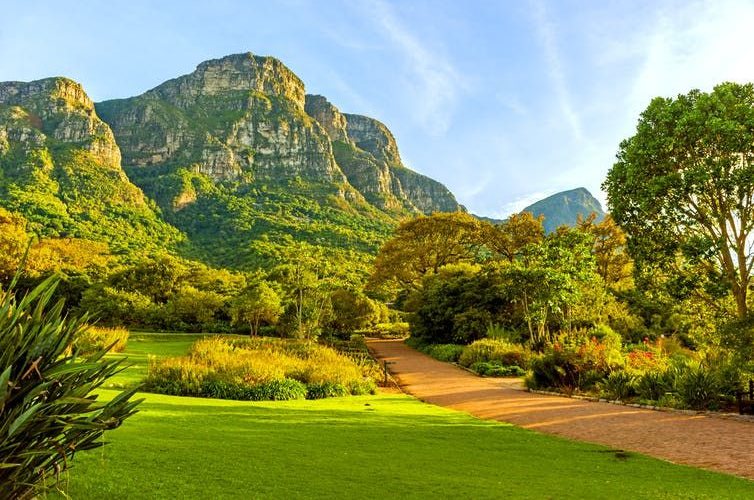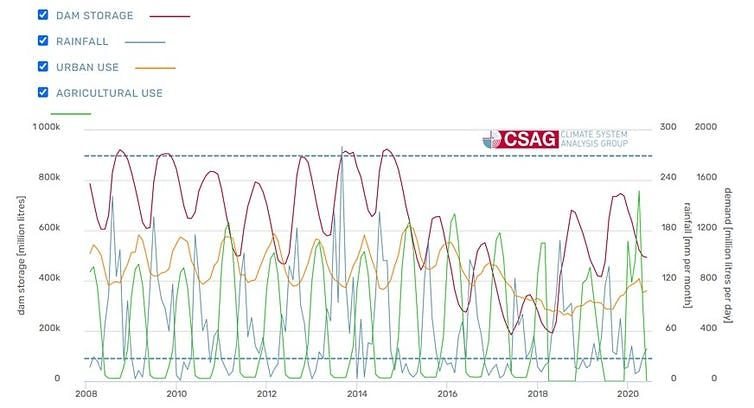What the tourism sector can learn from Cape Town's drought

Extreme droughts have been on the increase in southern Africa with far-reaching socioeconomic and environmental implications for the region. Assessing and documenting the impact of these extreme droughts has been lagging behind, a situation that has been bemoaned by academics and the Intergovernmental Panel on Climate Change.
To fill some of the gap, our study examined the causes and effects of climate change-induced droughts on the tourism industry in the Western Cape, a regional and continental tourism hub. Tourism is an important economic sector to Cape Town, and South Africa at large. The Western Cape attracted around 1.7 million international tourists in 2018 and generated R16.3 billion (about US$985 million) in foreign spending in 2019.
Our research found that the drought in Cape Town was caused by both natural and human (anthropogenic) drivers of climate change. This was compounded by increasing population and increased water demand in the province and Cape Town, in particular.
How the drought hit the tourism sector
The 2015 to 2018 drought was one of the longest and the worst to have affected Cape Town and the region in recent times. Rainfall declined from an annual average of about 493mm in 1993 to about 149mm per year in 2017. The drought turned into a crisis, given the extent of water scarcity, and received widespread media attention.
The politics around the issue worsened the situation. Given that the Western Cape is run by the country’s opposition party, the Democratic Alliance, there were delays over declaring the water situation in the province a national disaster. This limited the deployment of resources to the city crippling its response to the disaster. Declaring the drought as a disaster would’ve eased procurement processes and provided resources needed to deal with it. There were constant spats about the cause of the disaster, the extent and who was responsible for managing it.
International media coverage and the phrase “Day Zero water crisis” painted a bleak picture of the situation. This image of Cape Town as a city in crisis damaged perceptions of the destination. This resulted in tourists postponing or cancelling travel to what was one of the most popular destinations in the world.

Our study found that there was a decline between 1.3% and 12.6% on month on month tourism arrivals to the province in 2017 and 2018 at the peak of the drought. This resulted in a decline in hotel occupancy and tourist arrivals at the city’s most popular tourism sites such as V&A Waterfront, Table Mountain Cableway, Kirstenbosch Botanical Garden, Cape Point and other destinations.
The decline in arrivals severely undermined revenue generation for most tourism businesses and for the city, national parks and other private nature reserves in the area. Average tourist spend by international tourist declined by 30% between 2017 and 2018. The decline in arrivals on the other hand, in a way saved the situation by reducing water demand as the water consumption for the city declined by 50%.
We found that the impact on tourism businesses was disproportionate, with smaller and lower graded tourism accommodation establishments being worst affected. Four and five-star accommodation establishments weren’t as affected.
This could be attributed to perceived capacity to provide water from alternative sources to ensure a comfortable stay by guests. Our study found that some top hotels had invested in water harvesting technologies which allowed them to operate without reliance on city water supply.
Collaborations

The city of Cape Town and tourism industry stakeholders led by WesGRO – the Western Cape’s official tourism, trade and investment promotion agency – provided leadership that ensured the city adopted measures to reduce water use to avoid Day Zero. The public and private partnership proved crucial in ensuring water sustainability.
Universities also played a crucial role in terms of research, innovation and agenda setting. The tourism sector adopted measures, amongst them a well-coordinated campaign to encourage tourists to use less water, retrofitting of bathrooms to ensure water saving, investment into water harvesting technologies and investment in ocean water harvesting technologies.
As seen in the graph, water levels have improved since the cancellation of Day Zero. Cape Town and the Western Cape province must continue championing and ensuring water efficiency, putting in place measures to reduce water demand by every economic sector and build water resilience. Given that the drought is over, for now, there’s a need to use the drought levies that were instituted to put in place infrastructure that augments current water supply to build a water resilient city.
As we found in our study, in the event of future droughts, the use of terms and alarmist messages that may scare away investors and tourists should be avoided. The Day Zero experience is not a once-off event. As long as climate change continues, there are many other day zeros on the way in many cities around the world.
This article is republished from The Conversation under a Creative Commons license. Read the original article.
Source: The Conversation Africa

The Conversation Africa is an independent source of news and views from the academic and research community. Its aim is to promote better understanding of current affairs and complex issues, and allow for a better quality of public discourse and conversation.
Go to: https://theconversation.com/africa
























